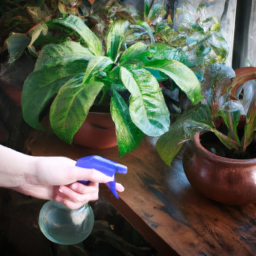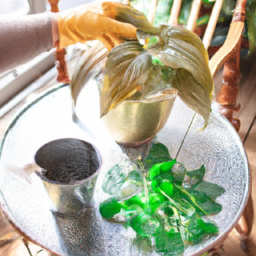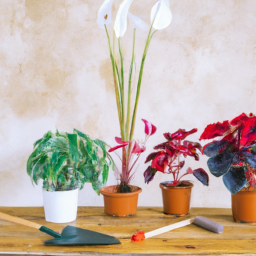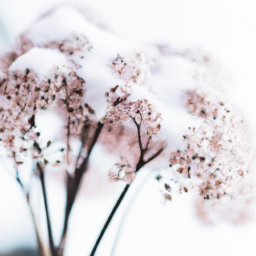
Winter Care for Indoor Plants: Keeping Your Greenery Thriving
As the winter season approaches, it’s time to start thinking about how to protect and care for your beloved indoor plants. With the colder temperatures and lower levels of natural light, our green friends can struggle to thrive during this time of year. But fear not! With a little extra attention and some simple tips, you can ensure that your indoor plants not only survive but also continue to flourish throughout the winter months. In this blog post, we will explore the best practices and strategies for winter care for indoor plants, so you can keep your greenery thriving and bring a touch of nature into your home all year round. Let’s dive in and discover how to keep your indoor plants happy and healthy during the colder months.
Importance of Proper Winter Care for Indoor Plants
Winter can be a challenging time for indoor plants as the cold temperatures and reduced sunlight can impact their growth and overall health. However, with proper care and attention, you can ensure that your greenery thrives even during the winter months. In this guide, we will discuss the importance of winter care for indoor plants and provide you with a step-by-step guide to help you keep your plants healthy and vibrant.
Understanding the Impact of Winter on Indoor Plants
During winter, the days become shorter, and the intensity of sunlight decreases. This reduced light can have a significant impact on indoor plants as they rely on photosynthesis to produce energy. Without sufficient light, plants may become weak, leggy, and may even stop growing altogether.
In addition to reduced sunlight, the lower temperatures during winter can also affect the growth of indoor plants. Most indoor plants are tropical or subtropical species that thrive in warm temperatures. When exposed to cold drafts or chilly environments, these plants can suffer from stress, leading to stunted growth, leaf drop, or even death.
Proper winter care is essential to help your indoor plants adapt to these challenging conditions and ensure their survival and well-being throughout the colder months.
Step-by-Step Guide to Winter Care for Indoor Plants
1. Assess the Lighting Conditions: Start by evaluating the lighting conditions in your home. Identify the areas with the brightest and longest exposure to sunlight. Place your plants in these areas to maximize their access to natural light. If necessary, consider using artificial grow lights to supplement the light requirements of your plants.
2. Adjust Watering Routine: During winter, indoor plants generally require less water due to reduced evaporation. Overwatering can lead to root rot and other fungal diseases. Check the soil moisture regularly and water only when the top inch of soil feels dry. Ensure proper drainage to prevent waterlogging.
3. Maintain Adequate Humidity: Indoor heating during winter can cause the air to become dry, which can be detrimental to your plants. Increase humidity levels around your plants by using a humidifier or placing a tray filled with water near them. Grouping plants together can also help create a microclimate with higher humidity.
4. Avoid Cold Drafts: Keep your indoor plants away from windows, doors, and other areas where cold drafts can occur. Cold drafts can shock the plants and cause damage. Ensure that the temperature around your plants remains stable and within the recommended range for each species.
5. Dust and Clean Leaves: Dust can accumulate on the leaves of indoor plants, blocking sunlight and hindering photosynthesis. Regularly wipe the leaves with a damp cloth to keep them clean and free from dust. This will help the plants absorb maximum light and stay healthy.
6. Prune and Trim: Winter is a good time to prune and trim your indoor plants. Remove any dead or yellowing leaves, as well as leggy growth. Pruning helps redirect energy to healthier parts of the plant and promotes better growth in the upcoming seasons.
7. Monitor for Pests and Diseases: Indoor plants are not immune to pests and diseases, even during winter. Inspect your plants regularly for signs of infestation or disease. If you notice any issues, take immediate action to prevent them from spreading. Use organic pest control methods or consult with a professional if needed.
8. Provide Proper Nutrients: Indoor plants may have reduced nutrient requirements during winter due to slower growth. Adjust your fertilization routine accordingly and use a balanced indoor plant fertilizer at half the recommended strength. Avoid over-fertilizing, as it can harm the plants.
9. Be Patient: Finally, remember that winter is a period of dormancy for many indoor plants. Growth may slow down, and some plants may shed leaves. Be patient and avoid overreacting to natural changes. With proper care, your plants will rebound and thrive when spring arrives.
By following these step-by-step guidelines for winter care, you can ensure that your indoor plants stay healthy, vibrant, and continue to bring life and beauty to your home throughout the winter months. Remember, each plant species may have specific care requirements, so always research and adapt your care routine accordingly. Enjoy the beauty of your greenery even during the coldest season!

Best Practices for Maintaining Indoor Plants During Winter
Winter can be a challenging time for indoor plants as they are exposed to lower light levels, drier air, and cooler temperatures. However, with the right care and attention, you can ensure that your greenery thrives even during the coldest months. In this guide, we will provide you with step-by-step instructions on how to keep your indoor plants healthy and vibrant throughout the winter season.
1. Adjusting Light Levels
During winter, the days are shorter and the sunlight is often weaker. This can have a significant impact on the growth and overall health of your indoor plants. To compensate for the reduced light levels, consider the following:
Positioning: Move your plants closer to windows to maximize the amount of natural light they receive. South-facing windows usually provide the brightest light, while east and west-facing windows offer moderate light levels. If you have limited access to natural light, consider using artificial grow lights to supplement the lighting.
Curtains and Blinds: Ensure that curtains or blinds are not blocking the light from reaching your plants. Keep them open during the day and close them at night to provide insulation against cold drafts.
Rotation: Rotate your plants every few weeks to ensure that all sides receive equal exposure to light. This will prevent them from leaning towards the light source and promote even growth.
2. Regulating Temperature and Humidity
Indoor plants have different temperature and humidity requirements, and it’s important to meet these needs during the winter months. Here’s what you can do:
Temperature: Most indoor plants thrive in temperatures between 60-75°F (15-24°C). Avoid placing them near cold drafts, such as windows and doors. If the temperature drops significantly in your home during the night, consider moving your plants to a warmer location, away from cold spots.
Humidity: Winter air tends to be drier due to indoor heating. To increase humidity around your plants, you can use a humidifier, place a tray of water near them, or mist their leaves with water. Grouping plants together also helps create a microclimate with higher humidity levels.
Avoid Overwatering: While it’s important to maintain adequate moisture levels, overwatering can be detrimental to your plants, especially during winter when they require less water. Check the soil moisture regularly and water only when the top inch of soil feels dry. Ensure proper drainage to prevent waterlogging.
3. Adjusting Fertilizer and Pruning
During winter, the growth rate of indoor plants slows down, and they require less fertilizer. Here are some tips to keep in mind:
Fertilizer: Reduce the frequency of fertilizer application to once every 6-8 weeks or follow the specific instructions for your plant species. Dilute the fertilizer to half the recommended strength to avoid overfeeding.
Pruning: Winter is a good time to prune your indoor plants and remove any dead, damaged, or yellowing leaves. Pruning not only improves the appearance of the plant but also stimulates new growth in the spring. Use clean and sharp pruning tools to avoid spreading diseases.
Pest Control: Winter is a time when pests tend to be less active, but it’s still important to keep an eye out for any signs of infestation. Inspect your plants regularly for pests like mealybugs, spider mites, or scale insects. If you notice any signs, treat them promptly using organic insecticidal soap or horticultural oil.
By following these best practices for maintaining indoor plants during winter, you can ensure that your greenery thrives and remains healthy throughout the colder months. Remember to adjust light levels, regulate temperature and humidity, and make necessary adjustments to fertilizer and pruning routines. With a little extra care, your indoor plants will continue to bring beauty and joy to your home all winter long.

Common Challenges and Solutions for Winter Care of Indoor Plants
Introduction
During the winter months, indoor plants face a unique set of challenges that can affect their overall health and growth. With lower light levels, drier air, and fluctuating temperatures, it’s important to provide proper care to ensure your greenery thrives throughout the season. In this guide, we will discuss some common challenges faced by indoor plants during winter and provide practical solutions to help you keep your plants healthy and vibrant.
1. Low Light Levels
One of the most significant challenges for indoor plants in winter is the decreased amount of natural light. With shorter days and less sunlight, plants may struggle to photosynthesize and produce energy. This can result in weakened growth and pale, leggy foliage.
To overcome this challenge, consider the following solutions:
1.1. Placement: Move your plants to the brightest areas of your home, such as near south-facing windows. This will maximize their exposure to available sunlight.
1.2. Artificial Lighting: Supplement natural light with artificial grow lights. LED grow lights are energy-efficient and provide the necessary light spectrum for plant growth.
1.3. Rotate Plants: Regularly rotate your plants to ensure all sides receive equal exposure to light. This will prevent uneven growth and encourage balanced development.
2. Dry Air
Indoor heating during winter can lead to dry air, which can be detrimental to the health of your indoor plants. Dry air increases water evaporation from the soil, causing it to dry out faster. It can also result in parched foliage and increased susceptibility to pests.
Here’s how you can combat dry air:
2.1. Humidity Trays: Place trays filled with water near your plants. As the water evaporates, it increases the humidity around them. Avoid placing the trays directly beneath the plants to prevent root rot.
2.2. Grouping Plants: Grouping plants together can create a microclimate of increased humidity. The plants release moisture through transpiration, raising the humidity levels around them.
2.3. Misting: Mist your plants regularly with room temperature water. This helps to increase humidity levels and keeps the foliage hydrated. Avoid misting plants with fuzzy leaves, as it can promote fungal growth.
3. Fluctuating Temperatures
Winter often brings fluctuating temperatures, especially near windows or doors. These temperature variations can stress indoor plants and hinder their growth.
Consider the following solutions to minimize the impact of fluctuating temperatures:
3.1. Insulate Windows: Use insulating window films or curtains to reduce heat loss and buffer temperature fluctuations near windows.
3.2. Maintain Optimal Room Temperature: Keep your indoor temperature consistent and within the ideal range for your plants. Avoid placing plants near drafty areas or heat sources.
3.3. Use Plant Covers: For plants near windows or doors, consider using plant covers or horticultural fleece during cold nights to provide an extra layer of insulation.
Conclusion
Winter care for indoor plants requires attention to their specific needs in order to keep them thriving. By addressing challenges such as low light levels, dry air, and fluctuating temperatures, you can provide the optimal conditions for your plants to grow and flourish throughout the winter season. Remember to regularly monitor your plants, adjust their care as needed, and enjoy the beauty and benefits they bring to your indoor space.
Here’s what we learned
Winter can be a challenging season for indoor plants, as the cold temperatures and dry air can take a toll on their health. However, with a little extra care and attention, you can keep your greenery thriving throughout the winter months. One important aspect of winter care is to ensure that your plants are getting enough light. Since the days are shorter and sunlight is scarce, it’s a good idea to move your plants closer to windows or invest in grow lights to provide them with the necessary light they need to thrive.
Another key consideration during winter is the humidity levels in your home. Central heating can cause the air to become dry, which is not ideal for most indoor plants. To combat this, you can use a humidifier to increase the moisture in the air or place your plants on trays filled with water and pebbles to create a humid microclimate around them. It’s also important to avoid placing your plants near drafts or heating vents, as the sudden temperature changes can be detrimental to their health. Lastly, be mindful of your watering routine. While it’s important to keep your plants hydrated, they may require less water during the winter months when their growth slows down. Always check the moisture level of the soil before watering and adjust accordingly. By following these simple tips, you can ensure that your indoor plants not only survive but thrive during the winter season.
Let me leave you with some FAQs:
Q1: How often should I water my indoor plants during the winter?
A1: The frequency of watering your indoor plants during winter depends on various factors such as the type of plant, the size of the pot, and the conditions in your home. Generally, indoor plants require less water during winter as they go through a period of dormancy. It is important to check the soil moisture before watering. Stick your finger about an inch into the soil, and if it feels dry, it’s time to water. However, be cautious not to overwater, as this can lead to root rot.
Q2: How do I ensure proper humidity levels for my indoor plants in winter?
A2: Maintaining adequate humidity levels is crucial for the well-being of your indoor plants during winter when the air tends to be drier. You can increase humidity by using a humidifier, placing a tray filled with water near your plants, or grouping them together to create a microclimate. Another effective method is to mist your plants regularly with water, especially their leaves. However, make sure not to mist plants that are prone to fungal diseases, as excess moisture can promote their growth.
Q3: Should I fertilize my indoor plants during the winter months?
A3: Indoor plants generally require less fertilizer during winter due to their slowed growth. It is advisable to reduce the frequency of fertilization to about once every two months or follow the specific instructions for your plant species. Use a diluted fertilizer to avoid overfeeding your plants. Remember, it’s important to allow your plants to rest during their dormant period, so refrain from excessive fertilization.
Q4: How can I protect my indoor plants from cold drafts near windows?
A4: Cold drafts near windows can be harmful to your indoor plants during winter. To protect them, you can move your plants away from drafty areas or create a barrier between the plants and the window using a curtain or a sheet of plastic. Alternatively, you can insulate the windows by using weatherstripping or applying window film to reduce heat loss and drafts. It’s essential to ensure your plants are not exposed to sudden temperature fluctuations.
Q5: What are some common signs of stress in indoor plants during winter?
A5: Indoor plants often exhibit signs of stress during winter due to the lower light levels and drier air. Some common signs include yellowing or browning of leaves, leaf drop, stunted growth, and wilting. Additionally, if you notice an accumulation of dust on the leaves, it can hinder their ability to photosynthesize effectively. Regularly dusting or gently wiping the leaves with a damp cloth can help alleviate this issue and keep your plants thriving.

James Wong is a renowned ethnobotanist, plant scientist, and local television presenter. With a passion for demystifying plant science, he is known for translating complex botanical concepts into practical advice for everyday plant enthusiasts. James’s expertise spans from traditional gardening to cutting-edge plant technologies, making his insights accessible and informative.


